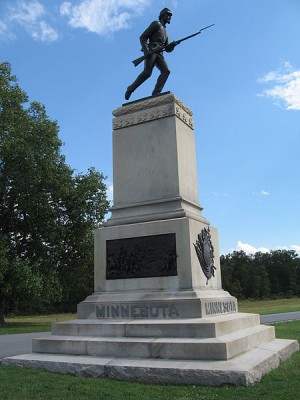First Minnesota
 Image source: Wikimedia Commons.
Image source: Wikimedia Commons.
Reading this story, my heart is in my throat.
The Battle of Gettysburg, Day 2, July 2nd, 1863.
“The scene is the center of the American line. Most of the attacks on the flanks have been repulsed by now, or nearly so, and the sun is near to setting. The American lines are now almost set into the famous ‘fish-hook’ formation that one can find on so many maps. But the operative word is ‘almost.’
“In the center, there is a gap…”
The writer is Lt. Col. Robert Bateman, and his recounting of the events in the weeks leading up to Gettysburg has had me enthralled for days. I’ve followed him from Fredericksburg, Virginia—the town, incidentally, where I graduated from college, and where I met Scott—north to Pennsylvania, his posts spanning the months of June and July, 1863, just over 150 years ago. I don’t particularly want to be in Gettysburg right now; my attention ought to be far to the south, in Alabama. But I can’t look away. Lt. Col. Bateman’s account is riveting.
“In the center, there is a gap because one American Corps commander took it upon himself to move well forward earlier in the fight. The rebels are now finishing crushing that Corps. But ever since that audacious Union Corps commander created that gap in the first place, a succession of recently arriving units have been fighting to keep the middle from collapsing. Now, as the sun sets over Seminary Ridge, the game is almost over. But there is a half-mile opening in the remaining American line, and two whole rebel brigades are headed straight to it.”
You’ll have to read the entire post to get the full thrust of what’s on the line in this moment—heck, you ought to read the whole series—but some of you will understand why this next passage made me gasp.
The American Corps commander now in charge of the section of the line closest to the hole, a fellow named Hancock, sees what is about to happen. The rebels are moments away from breaking the center of the Union line. His own Corps line ends several hundred yards to the north. The next American unit to the south is a quarter mile away. Hancock can see the reinforcements he has called for, as can others on the crest of the hill. Those troops are marching at full speed up the road. By later estimates, the relieving troops are a mere five minutes away from the ridgeline. But the Confederates are closer.
I talked about psychology yesterday. I wrote about how sometimes something that can only be described as moral ascendency (or perhaps morale ascendency) can make it possible for a smaller force to defeat a larger force — first emotionally, then physically. Rufus Dawes and his 6th Wisconsin Infantry pulled that off on the First Day, albeit at a horrendous cost. General Hancock understands in an instant the bigger picture. This is not some small slice of the field. He sees that if the rebels make it to the ridge, they might gain the psychological advantage over the whole Army of the Potomac, much of which is still arriving. So the rebels must be stopped. Now. Here.
And now, what I am about to describe to you transcends my own ability to explain. Hell, it is beyond my own understanding, and I have been a soldier for decades.
General Hancock sees a single American regiment available. But, though it is a “regiment,” this is in name only at this point. A “regiment,” at the beginning of the war, would be roughly 1,000 men. Before Hancock stand 262 men in American blue. Coming towards them, little more than 250 yards away now, are two entire brigades of rebels. Most directly, half of that force — probably about some 1,500 men from a rebel brigade — were coming dead at them. Perhaps a thousand more, at least two entire additional regiments, were on-line with that main attack, though probably unseen by Hancock. But what does that matter? The odds were, already, beyond comprehension.
“My God! All these all the men we have here…What regiment is this?” Hancock yelled.
“First Minnesota,” responded the colonel, a fellow named Colvill.
First Minnesota.
 That’s right, Lovelace readers. The very regiment Emily Webster’s grandfather fought in, the one Carney’s Uncle Aaron (her great-uncle, surely) died in—in that charge on the second day of the Battle of Gettysburg.
That’s right, Lovelace readers. The very regiment Emily Webster’s grandfather fought in, the one Carney’s Uncle Aaron (her great-uncle, surely) died in—in that charge on the second day of the Battle of Gettysburg.
“When Colonel Colville told us to charge,” [Grandpa] said, nobody ran out on that field any faster than Aaron Sibley.”
“You ran fast enough to get a bullet through your arm.”
“Only winged, only winged,” he answered impatiently. “It might have been death for any one of us.”
It was for a good many of them, Emily remembered. She had heard her grandfather say many times that only forty-seven had come back out of two hundred and sixty-two who had made the gallant charge.
—from Emily of Deep Valley by Maud Hart Lovelace
“Every single man of the 1st Minnesota,” writes Lt. Col. Bateman,
“placed as it was at the crest of the gentle slope, could see what was going on. All of them were veterans, having fought since the beginning of the war. Each of them understood the exact extent of what they were being asked to do by General Hancock. And, it would appear, that they all understood why.
“On this day, at the closing of the day, there was no illusion that they might win. There was not any thought that they could throw back a force more than seven or eight times their own size. Not a one of them could have entertained the idea that this could end well for them, personally.
“I suspect, though of course nobody can actually ‘know,’ that there was only a silent, and complete, understanding that this thing must be done. So that five minutes might be won for the line and the reinforcements and that their widows and children might grown up in a nation once more united, they would have to do this thing. Then, as men, the 262 men of the 1st Minnesota followed their colonel as he ordered the advance, leading them himself, from the front.
“They charged, with fixed bayonets, to win 300 seconds for the United States. Union and Confederate sources agree on this next point: There was no slacking, no hesitation, no faltering. The 1st Minnesota charged, en masse, at once alone and together. One hundred and fifty years later, those 300 seconds they then won for the United States have proven timeless. Because it worked. They threw a wrench into the rebel attack, stalling it, before the inevitable end.
“And, as Fox’s Compendium pointed out in cold, hard numbers, it only cost 82 percent of the men who stepped forward.”
Grandpa Webster and Aaron Sibley are fictional characters, but they are based on real people, just as Emily and Carney were. In the afterword to HarperPerennial’s 2010 edition of Emily of Deep Valley, Lovelace historian Julie A. Schrader tells us that Grandpa Cyrus Webster represented a man named John Quincy Adams Marsh, the grandfather of Maud’s friend Marguerite Marsh, the “real” Emily. He was not, however, a Civil War veteran. Schrader writes,
“Maud appears to have based Grandpa Webster’s experiences on those of Captain Clark Keysor (Cap’ Klein)…. General James H. Baker, a veteran of the Dakota Conflict and the Civil War, was the basis for the character of Judge Hodges. In 1952 Maud wrote, ‘Old Cap’ Keysor and General Baker used to visit the various grades on Decoration Day to tell us about the Civil War…'”
Emily is, as I’ve often mentioned, not only my favorite Maud Hart Lovelace book, it’s one of my favorite novels period. Grandpa Webster is very real to me. I can’t describe my astonishment to find him there, suddenly, in Lt. Col. Bateman’s account, rushing unhesitatingly toward that gap in the line. 262 men made the charge. 47 survived. One of them was Cap’ Clark Keysor, who visited Maud’s school classrooms and told her stories she never forgot. Nor shall I.
***
For Lt. Col. Bateman’s entire Gettysburg series, click here.
For more background on the real people who inspired Maud Hart Lovelace’s characters, I highly recommend Julie Schrader’s book, Maud Hart Lovelace’s Deep Valley.
Related posts:
Why I love Carney
Why I love Emily
A Reader’s Guide to Betsy-Tacy

Sarah says:
That was so moving. I started reading it aloud to my husband, but had to stop so I didn’t embarrass myself by crying.
Do you know of a book where I might read more about this?
On August 16, 2013 at 5:03 am
John T says:
I went to Esquire to read the full article… and then the other Gettysburg articles… and then the other Civil War articles… and then the rest of the articles by LTC Bateman.
Sigh. I think I’d better just bookmark this or I am going to get fired.
On August 16, 2013 at 7:06 am
Melissa Wiley says:
I’m so with you. His most recent piece about Robert E. Lee and George Thomas (which is how I found him) is one of the best things I’ve read all year. Fortunately for me, my current job requires a great deal of reading about the Civil War. 🙂
On August 16, 2013 at 7:57 am
Melissa Wiley says:
Sarah, one of LTC Bateman’s commenters recommends a book called Last Full Measure: The Life and Death of the First Minnesota Volunteers.
On August 16, 2013 at 8:01 am
sarah says:
Oh my goodness! Lissa, you won’t believe what I just picked up to read a few days ago–Emily of Deep Valley! It’s my first read through. I’m already in love.
On August 16, 2013 at 8:30 am
COD says:
In my Civil War “studies” following my son around the battlefields I’ve been shocked at how often 5 minutes was the line between disaster and success in the Civil War.
On August 16, 2013 at 8:54 am
Sir Knowitall says:
“In the center, there is a gap because one American Corps commander took it upon himself to move well forward earlier in the fight. ”
That corps commander was Daniel Sickles, a Tammany Hall political general. Sickles was the first man in American legal history to be exonerated on a charge of murder based on a defense of “temporary insanity.” Sickles had shot Philip Barton Key, attorney general for the District of Columbia and Sickles’ wife’s lover. Key’s father was Francis Scott Key, the composer of the Star Spangled Banner. Aint history grand?
Excellent Gettysburg books
Gettysburg–Alan Guelzo
Gettysburg–Stephen Sears (personal favorite)
Gettysburg: A Testing of Courage–Noah Andre Trudeau
The Gettysburg Campaign: A Study in Command–Edward Coddington (not for the faint of heart)
On August 16, 2013 at 9:28 am
Jan says:
Wow. That’s all I can say. I’m a little weepy. Emily is my favorite Maud book, too. And I also think it is one of the best I’ve ever read. You just made Grandpa Webster even more real to me. Thank you.
On August 16, 2013 at 4:04 pm